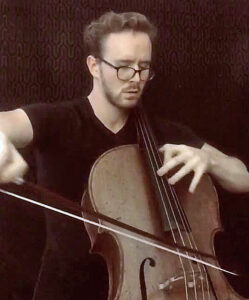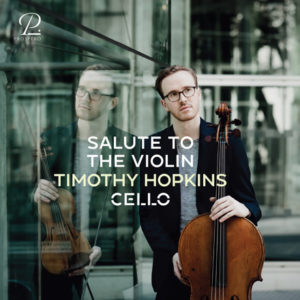Timothy Hopkins’ first instrument was the piano, then he discovered the cello. With a musical home, his curiosity and a little bit of luck in his luggage – as he says himself – he made rapid progress: While he was still going to school, he became a junior student, later completing his bachelor’s and master’s degrees in Leipzig and Berlin. However, the ambitious young artist’s first career steps fell during the lockdown period of the corona pandemic – and put a « good spanner in the works » for Hopkins, as he tells us in an interview.
 « I had just decided not to wait any longer for inquiries to come, but to finally acquire my own concerts independently, gain experience and get a foot in the door to the action. » Then the pandemic intervened and « took the wind out of his sails ». Hopkins made a virtue out of necessity: it was « the perfect time » to record a CD. « I had a lot of time to practice and to plan. In that regard, it was a pretty productive creative phase for me. » The result was « Salute to the Violin », Hopkins’ first album.
« I had just decided not to wait any longer for inquiries to come, but to finally acquire my own concerts independently, gain experience and get a foot in the door to the action. » Then the pandemic intervened and « took the wind out of his sails ». Hopkins made a virtue out of necessity: it was « the perfect time » to record a CD. « I had a lot of time to practice and to plan. In that regard, it was a pretty productive creative phase for me. » The result was « Salute to the Violin », Hopkins’ first album.
Hopkins has always enjoyed playing violin works on the cello, as he explains. In general, he has a passion for arranging literature for his instrument that is not really intended for the cello. « There are several reasons why this excites me, » Hopkins says. « Since there are relatively few works composed by cellists – unlike with the piano and the violin – it often happens that ‘the cello technique from the textbook’ does not help us. Sometimes – even with standard works – there is no way around finding acrobatic fingerings and all sorts of cellistic tricks with a lot of creativity. »
 With the cello, there is not « one solution for everything, but every now and then you get the feeling that you have to develop a new, individual technique for each work ». So, on the one hand, it is « a very nice exercise to find ways to play pieces of other instruments on the cello ». On the other hand, it is also « a great feeling to be able to play anything you want – no matter how impossible it may seem ». In addition, there are works « that I just couldn’t get out of my head, and absolutely had to play myself ». Hopkins mentions Bach’s Chaconne, which can also be heard on the album.
With the cello, there is not « one solution for everything, but every now and then you get the feeling that you have to develop a new, individual technique for each work ». So, on the one hand, it is « a very nice exercise to find ways to play pieces of other instruments on the cello ». On the other hand, it is also « a great feeling to be able to play anything you want – no matter how impossible it may seem ». In addition, there are works « that I just couldn’t get out of my head, and absolutely had to play myself ». Hopkins mentions Bach’s Chaconne, which can also be heard on the album.
His teacher, the Danish cellist Troels Svane, once said of Hopkins that the mastering of violin literature had helped Hopkins to « astonishing virtuosity ». Does the young artist agree? Hopkins answers modestly: « Since you inevitably get used to your own standard and become more and more critical of yourself as you progress – it goes hand in hand, at least it does for me – it is rare to be ‘astonished’ by your own virtuosity. If you look at it that way, only a listening person can judge this”. Nevertheless, he has « learned an enormous amount by playing violin literature, probably more than I realize ». This makes it much easier for him, and he approaches some challenges in original cello works differently than before.
The plans for the coming years are already set: « I hope to record many more albums, » says Hopkins. « And although I’m passionate about playing violin literature, that doesn’t mean I love standard cello literature any less. »
But since he was still at the beginning of his career, « I thought it was not a bad idea not to do the same as everyone else ». Because: « First of all, I wanted to show off ‘what I am capable of’ and make myself heard. »
If you listen to his first CD and read the reviews, he has probably already succeeded.
https://www.pizzicato.lu/ikonische-violinliteratur-im-lebendigen-celloklang/
























